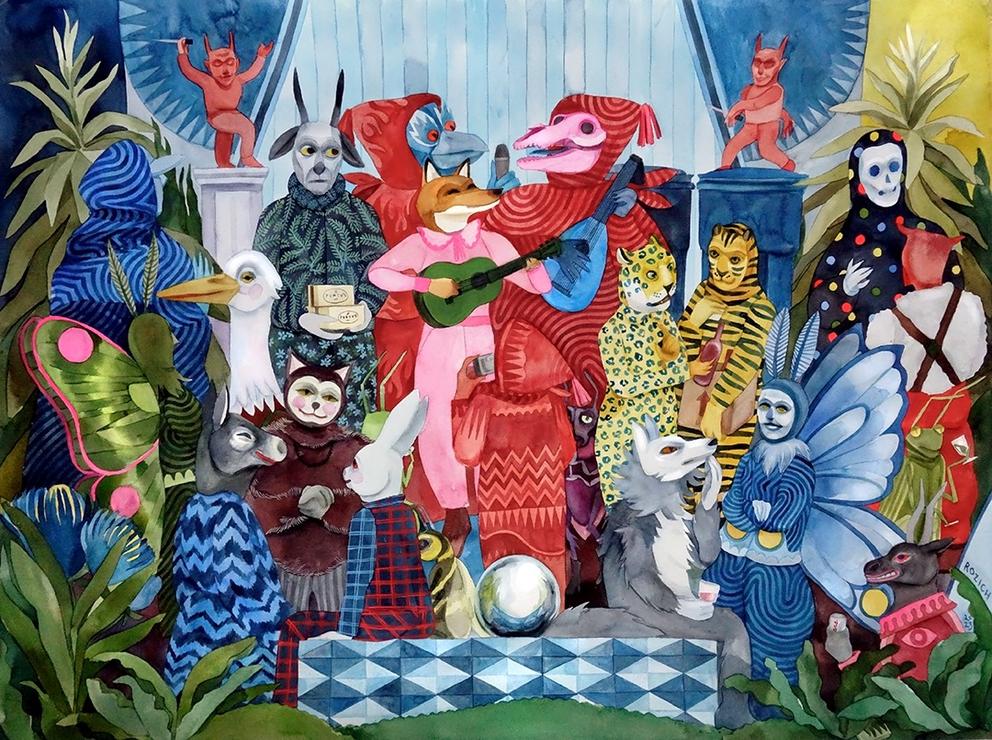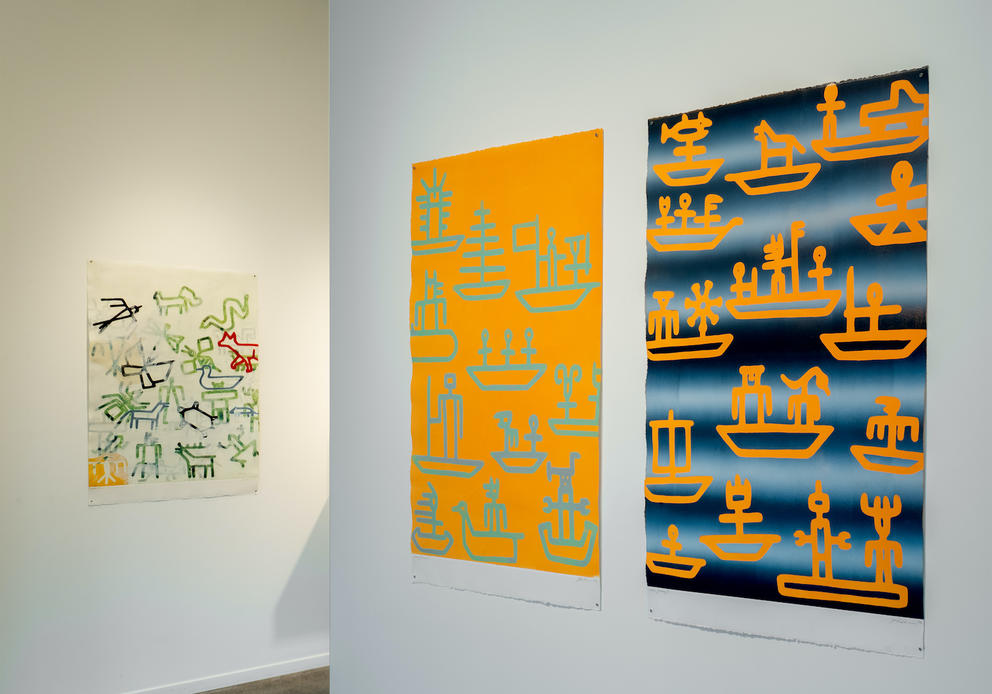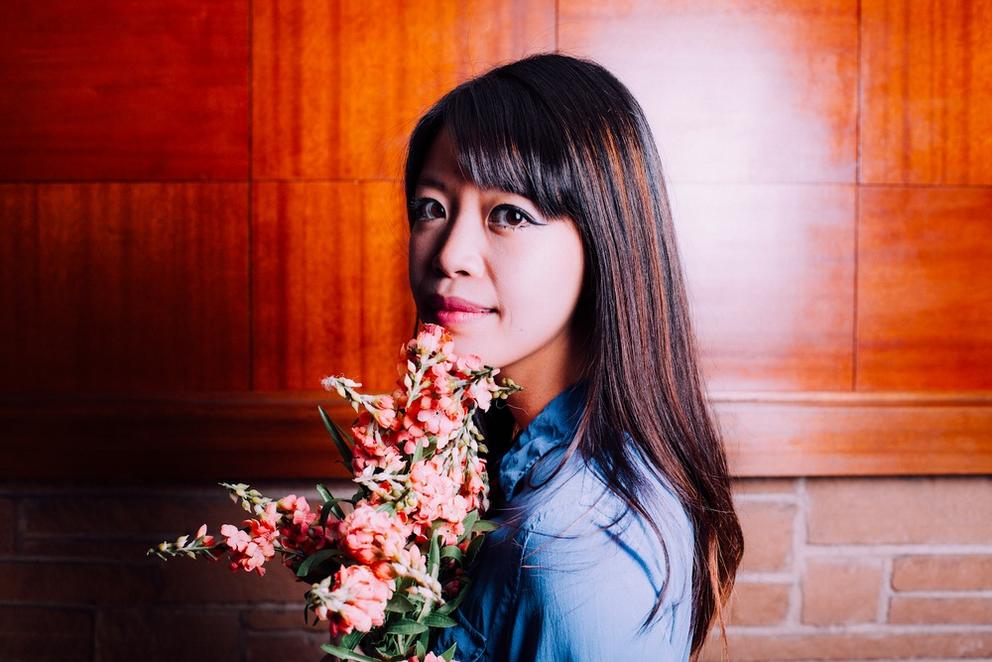It’s Folklife’s 52nd year, and as usual the lineup is a truly remarkable mix of arts from all over, including folk dance traditions from Hawaii to Hungary, Brazil to Croatia. Among the delightfully diverse offerings are a fiddle showcase, a klezmer jam, a Chinese fashion show and a “twerkshop.”
ArtSEA: Notes on Northwest Culture is Crosscut’s weekly arts & culture newsletter.
Folklife artistic director Benjamin Hunter, whom Crosscut profiled in the Black Arts Legacies project this week, explains why these traditions work together. “To me, folk is everything,” he says. “Hip-hop is folk, classical is folk. Whatever, wherever people find community and an opportunity to share and shape an identity with people around you, I think, is folk.”
That communal folk feeling finds a resonance in the paintings of Stacey Rozich, a born-and-raised Seattleite currently based in LA. (Her chalkboard-artist father John Rozich’s work was once standard on the menu boards at local cafes.) In her new show Moments in Between (at Koplin Del Rio Gallery through June 3), she employs watercolors and her sense of humor to convey creatures inspired by folklore, medieval iconography and her own vivid dreams.
To me, Rozich’s multicolored works have always seemed ripped from a storybook. In “These Are the Days of Our Lives,” a rabbit, wolf, ladybug and jaguar share a bottle of wine while three devils dance in the distance. In “New Hobby, Old Friends,” another gathering of animals concentrates on a Ouija board. A colorful quartet of clownish moths suggests tarot-like predictions. Always, the playfulness veils the darker edge of a mysterious world beyond.
Rozich’s show is one of several worth heading to Georgetown for this weekend. Studio e Gallery is hosting a terrific exhibit of vibrant work by longtime Okanagan/Arrow Lakes artist Joe Feddersen (open Friday - Saturday through May 27).
These recent monoprints, glass pieces and baskets dance with Feddersen’s signature iconography: petroglyphs that symbolize sailboats, forests, bearded men, snakes, submarines and electrical towers — ages-old imagery and contemporary ephemera that combine in the Northwest landscape. Particularly charming is Feddersen’s curtain of delicate glass glyphs, which (thanks to a ceiling fan) clink against each other in a sweet song of the West.
For a totally different take on symbolism, head to nearby Mini Mart City Park, where Seattle artist Anna Mlasowsky is showing a sculptural series called Things that Talk (open Friday - Saturday through May 27). On Instagram Mlasowsky explains that these “humanoid but not figurative sculptures … ponder, visualize, and play with the experience of being a woman while rejecting traditional expectations of womanhood.”
So what does that look like? A stack of egg-carton memory-foam squares completely encrusted with black poppyseeds and weighted down by a chunk of obsidian. Purple-flocked bubbles in a floating estrogen molecule. Breasts cast in plaster and piled with powdered milk. And berry-pink blown-glass buttocks.
Similarly thick with poetic imagery is the new memoir by Jane Wong. In Meet Me Tonight in Atlantic City the Seattle poet tells a story of coming of age in America — specifically, when your parents run a Chinese restaurant on the Jersey shore.
In Wong’s telling, timelines collapse and fold over and turn back, as they do in our own minds. But she starts in 1854, with the first tourist train to land in Atlantic City. And already we know we’re in the hands of a poet when she tells us of the Atlantic Ocean “steel blue — the color of whales they’ll never see,” of the women who walked with “frilled umbrellas — jellyfish along the shore.”
With her father lost to a gambling addiction, Wong’s mother plays a starring role. The mole above her left eye is “a glowing planet not yet discovered,” her laugh “like a bursting tomato, seeds spilling everywhere.” There’s an urgency here, a gobbling speed that matches the intensity of the flavors spilling out of the restaurant kitchen. Hear it for yourself when Wong reads as part of “Nonfiction for No Reason,” a mixed bill of writers at Third Place Books Seward Park (May 25, 7 p.m.).
If Memorial Day has you in the mood for more memoir, try another new autobiography from a local artist of note. Illusions of Camelot is a surprisingly revealing coming-of-age story by Pacific Northwest Ballet artistic director Peter Boal. This book too is saturated in a sense of place, but instead of the sticky boardwalks of Atlantic City, it begins in the upper-class enclave of Bedford, New York.
Like Wong, Boal’s family had to manage a father with an addiction (his died young of alcoholism). But Boal was lucky to have found dance at age 9, which set him on a path to becoming a principal dancer for the New York City Ballet — and eventually to his current role in Seattle. He’ll read from the memoir at Elliott Bay Books (May 31, 7 p.m.).
With thoughts of young dancers who dream of the big stage, it seems like a good time to mention that the final production of Pacific Northwest Ballet’s 50th-anniversary season is coming up soon. Worlds to Come (June 2 - 11) is a mixed bill featuring works by up-and-coming choreographers Annabelle Lopez Ochoa, Edwaard Liang and former PNB dancer Kiyon Ross. The pieces look ahead to the future of ballet — a form that has long found inspiration in the communal joy of folk dances.
Get the latest in local arts and culture
This weekly newsletter brings arts news and cultural events straight to your inbox.





